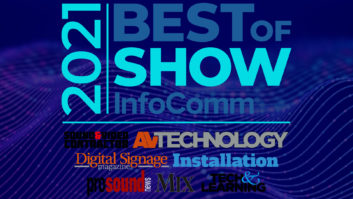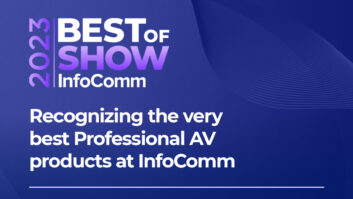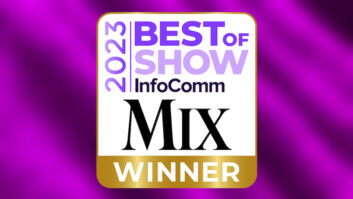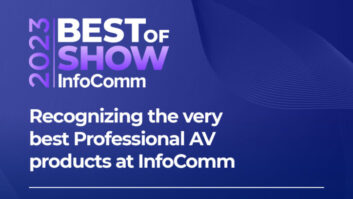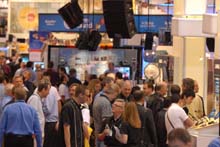
Touted as the largest pro AV trade show ever, InfoComm 2008 returned to Las Vegas, this time merged into a single event in conjunction with NSCA, to record success: 34,600 attendees and nearly 1,000 exhibitors.
This year’s show attracted AV dealers, independent reps, design consultants, systems integrators, rental and staging companies and AV buyers from business, government, education, health care, retail, entertainment and the worship market. Besides a wide-ranging selection of classes, seminars, sessions and panels on business practices, trends and technologies, the show floor was packed, mostly with active pros checking out the latest in new gear.
“InfoComm 08 reflects the fast pace of innovations and growth in the AV communications industry,” said InfoComm International’s Randal A. Lemke. “We introduced new courses and exhibitors this year to address the demand for digital signage, audio and telepresence technology, as well as high definition products, lighting and staging and more. The NSCA Expo also was incorporated into our show for the first time, and we were pleased to debut the Electronic Systems Pavilion, along with the rest of the Expo’s traditional activities.”
As with NAB and other mixed audio/video shows, a majority of InfoComm was devoted to visuals—video and display gear, from digital signage, video walls and projectors to teleconferencing and touchscreens. However, those brave souls who made it to the back of the cavernous Central Hall of the Las Vegas Convention Center were treated to the Audio Pavilion, where more than 200 audio manufacturers filled booths and demo rooms with the latest toys for live sound applications.
There lies the rub. From an exhibitors’ standpoint, part of the allure of merging a mostly-audio show like NCSA with a mostly-visual show like InfoComm is the ability to expose your cool audio stuff to a new audience. So from one viewpoint, mixing the audio and video booths has its advantages, yet at the same time, having all your audio in a single location makes one-stop destination shopping that much easier. The jury’s still out on that one, but at least for me, putting all the audio in one section made my job easier, while retaining a bit of the one-room show feel of NSCA’s past.
Certified Hits
Besides the rows of ceiling speakers, paging horns, intercoms and nurse-call systems, there were plenty of new audio products for live sound pros. Here, listed alphabetically, are my picks for the top-10 Mix Certified Hit products from InfoComm.
As an example of one of those “why didn’t I think of this first?” ideas, AKG unveiled the C 214, a lower-cost (cardioid-only) version of its venerable classic C 414 that delivers the same sonic performance as its legendary multipattern C 414B-XLS cousin. Sound reinforcement pros will appreciate the C 214’s road-tough construction, with a die-cast metal body, scratch-resistant finish and strong metal grille. Add in switchable 160Hz low-cut filter and -20dB pad, and the C 214 will surely be a popular addition on riders—especially at a $649 retail, with shock-mount, windscreen and metal carry case.
Analog consoles were alive and well, with new models debuting from Yamaha, Allen & Heath and APB-DynaSonics, which unveiled the ProDesk-4, a 4-bus design derived from the company’s top-end Spectra boards. It’s available with 16, 24, 32, 40 or 48 mono mic/line input channels (plus four stereo line inputs) and features 4-band sweep-mid EQ, six aux sends, L/C/R/mono XLR outs, digital USB stereo input/record output and remote muting that can be linked to a fire safety system.
Astatic/CAD’s new boundary mics—available in tabletop (930VPL) and threaded button-styles (220VP)—caught me by surprise. Both contain hidden controls that allow the installer to select continuously variable polar patterns, from figure-8 through cardioid through omni, and anything in-between. Smart!
Speaking of mics, Audix demo’ed an update to its popular Micros Series M1250 miniature condenser mic, which is less than 2 inches long, with electronics. The new M1255 has a 12dB hotter output that’s ideal for distance miking, such as hung overhead choir mics. A wide array of clips and mounts are offered.
Electro-Voice unveiled its innovative line of Tour-X loudspeakers. The series comprises 12-, 15- and twin-15 two-way top boxes, a dual-18 sub and 12-/15-inch wedges. The Tour-X Series is a solid mid-market contender, thanks to a lot of little minor improvements—such as the new Ergo-Handles for easier transport; amazingly strong, arc-shaped protective front grills; low-distortion 500-watt SMX woofers; and offset front baffles combining acoustical driver alignment with space-saving slot porting and 36dB/octave passive crossovers.

FiberPlex STP64 LightViper Shadow
The FiberPlex LightViper Shadow system is designed for touring, broadcast, fixed installs and remote recording, handling just about anything—audio, intercom, Ethernet, RS-422/232/485 control, composite video, TTL data—and with optional component modules, DMX lighting, MIDI and other control protocols. The system begins as a compact two-rackspace unit with 16 remote mic preamps and can expand in a star topology to 256 bi-directional audio channels at speeds up to 192kHz and full system redundancy.
Klein + Hummel’s IS Series demonstrated just how much live sound speakers can sound like studio monitors. The two-way IS 122 has a 12-inch woofer and 1-inch compression driver; the three-way IS 123 and IS 153 combine a 12- or 15-inch LF with a coaxial horn fed by 1-inch and 2-inch drivers. All feature highly-controlled Mathematically Modeled Dispersion and options are numerous, including 80×50 or 50×40 degree horns, subwoofers and a choice of crossovers—passive, active external or self-powered with analog or digital inputs.

Meyer Sound UPQ-1P Wide Coverage Loudspeaker
Meyer Sound expanded its popular UltraSeries with the powered UPQ-1P Wide Coverage Loudspeaker, delivering 136dB peak SPLs combined with low distortion performance, flexible rigging options and wide, uniform 80×50-degree coverage. the compact 19x28x18-inch box contains a 15-inch neodymium woofer and 4-inch diaphragm compression driver for a 55 to 18k Hz response.

Renkus-Heinz IC Live
Interest in steerable arrays remains high. Renkus-Heinz unveiled IC Live, which takes its successful Iconyx concept and applies it in a high-SPL package for portable applications. Each IC Live module has five neodymium 6.5-inch cone woofers and three neodymium compression drivers on waveguides. Arrays can be stacked on the complementary ICL215S dual-15 subwoofers or flown using standard Aeroquip hardware. Using standard Ethernet, the company’s RHAON networking delivers audio signals via CobraNet, AES/EBU digital or analog inputs, with PC access for real-time system control and room tuning functions such as parametric EQ filters, delay and dynamics—all with preset storage.
Tannoy launched its QFlex, a line of self powered, digitally steerable loudspeaker arrays. The series is based on combinations of eight- or 16-channel master and slave units, using combinations of up to 48 3- and/or 4-inch LF units and 1-inch tweeters, with individual 100-watt amplifier channels on each driver for full-range performance. The system also integrates DSP control with Tannoy’s Vnet networking and an intuitive GUI for system design/optimization.
We’ll present more products from InfoComm on http://mixonline.com/ and in future issues of Mix.
InfoComm 2009 will be held in Orlando, Fla. at the Orange County Convention Center in the West Halls, June 17 to 19, 2009. See you there!

